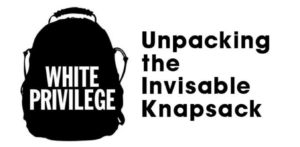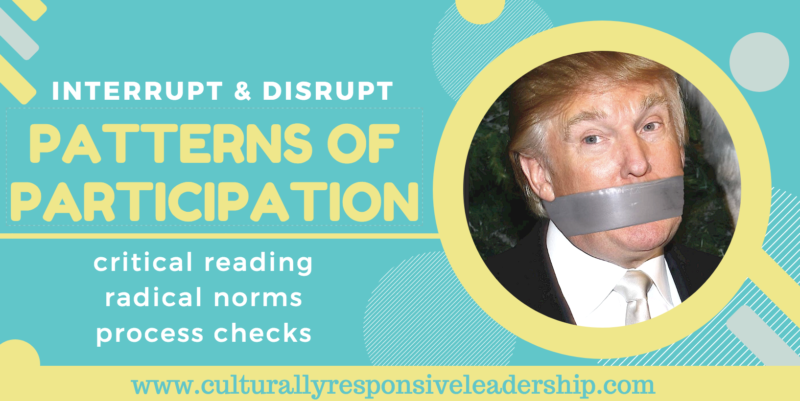Stop Talking White Man – Interrupting Patterns of Participation in School Staff Meetings
You want to disrupt patriarchy and white supremacy in the curriculum and in our learning outcomes. But, these patterns of oppression start in our adult interactions, and boy does it show up in meetings. See what you can do about it interrupting these patterns in staff meeting.
Although difficult, it is possible to take action with some critical reading, braver norms, and the use of process checks. In order to change racist academic outcomes, your staff needs to talk about teaching and learning in different ways. This requires new mindsets, tools, and ways of being. It also means different people need to talk and bu different I mean folks of color. Folks who have no confusion about their solidarity with the marginalized. Folks of color who can speak from experience. Folks who can push and will push. The problem is they need to space to do so.
Many times, white male staff feel very comfortable speaking up, speaking first, and filling the time. Even ha omg the last word, even if just to voice disagreement. Sometimes, this gets disguised as “the voice of experience” because many staff of color tend to be younger, newer to teaching, and more transient in large urban school districts. But, the result is that people of color and women are often quieted and marginalized.
Silenced.
It’s time to turn up the volume. But how?
As an African American male, I have felt unconfident and unwelcome in new spaces, predominately white spaces, and sometimes in “veteran” spaces. I have wondered: Do I belong here? Does my opinion matter? What will people think?
These are all thoughts resting in the rungs of racial hierarchy. Sitting in a meeting, I have looked around watched everyone jump in, and thought I had to “wait my turn.” Also, I have seen how people reacted to my comments and how the conversation took “another direction.” I thought, Oh, you gonna do me like that?
I still sometimes feel silenced in meetings, even in my role as a school leader. In meetings, I try to step back and create space for people to speak. Often times, I have seen white staff “step up” and speak. But it’s my responsibility to do something about this. When I redirect in the moment, I am often met with resistance, defensiveness, and people shutting down.
I feel like I am the UN Police, looking for human rights violations.
That ain’t fun.

The question is: how do we create the proper conditions to create different patterns of participation, different practices with students, and different outcomes?
Step 1: Explore and Discuss Critical Readings
Radical conditions start with shared understanding and awareness. One of the best ways to start this is through reading, reflection, and discussion.

Here are a few texts to get you started:
- White Privilege: Unpacking The Invisible Knapsack by McIntosh
- Changing the Discourse in Schools, by Eubanks, Parish, and Smith
- From Safe to Brave SpaceO
- Here’s hella books to get real busy:
- Once there is a shared understanding, a group can set norms with a good protocol.
Step 2: Create Braver Norms
Although many places have norms, they are not always in service of equity and disrupting systemic oppression. The right norms are like critical race theory or critical pedagogy applied to meetings. It’s a way of humanizing everyone in the room. It helps to level the playing field. It is also a way to interrupt oppression, in real time, with real people.
Everyone deserves to talk, and if we were only looking for equality, we would go in a circle and time each comment. But we are engineering for equity, and that means encouraging and fostering voices that historically have been silenced. That means asking white teachers to be mindful of their privilege and asking males to actively work against patriarchy.

Tip: Don’t confuse operational Norms with relational norms
I have seen many agendas with norms about showing up on time, getting things done, or taking good notes. While important, these operational norms do not create the conditions for a more humanizing experience for marginalized and oppressed peoples.
Also, when you can only pick a few norms, they occupy prime relational real estate. You will return to these often, you might read them every meeting, and you might even define them. How about you make your norms bold; remind people how we should be treated.
Turn Safe Norms into Braver Norms
- Share the air -> Check your privilege
- Step up step back -> Encourage female and POC voices
- Speak your truth -> Go beneath the surface
Step 3: Use Heavy Handed Facilitator Moves
It your responsibility as the facilitator to uphold norms, once you have them established, and that starts with you, the leader. Specifically, there are moves the facilitator can make to interrupt patriarchy and white supremacy:
- Taking stack and calling on discussants
- 2 cents protocol (link)
- Calling on people directly (“We have heard from 10 males and 4 females. Are there any females that would like to add to the conversation?”)
- Make it a role and process check at the end. Use a sheet.
Lessons Learned
In addition to having norms about patterns of participation, I have seen true growth when my school started using process checks, at the end of meetings. Process checks strengthen understanding and use of Discourse 1/2. Process Checks are a way to record how norms shows up and reflect on them at the end of a meeting.
Sometimes, I have been waiting for another staff member to step up and call folks out. Other times, I have waited for people who often don’t speak to speak. However, I have seen better results by creating the space to establish deeper norms (future link) and by having folks of color explicitly state that they want to speak up. I have also seen patterns change when multiple team members are observing patterns and informally facilitating. Finally, Process Checks help tremendously.
In conclusion, this is about changing the patterns of who talks, ideally changing the trajectory of the conversation. This should create the conditions for different conversations and changes to your school’s practice. Ultimately, you want the outcomes to change for students of color, for low-income students, and for immigrant youth.
Start with how adults interact and talk.
Stay Connected and Updated
Resources
What pattern do you want to interrupt? How?


